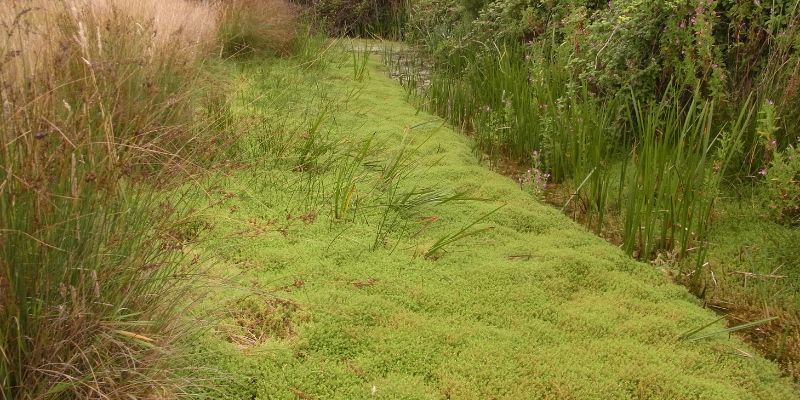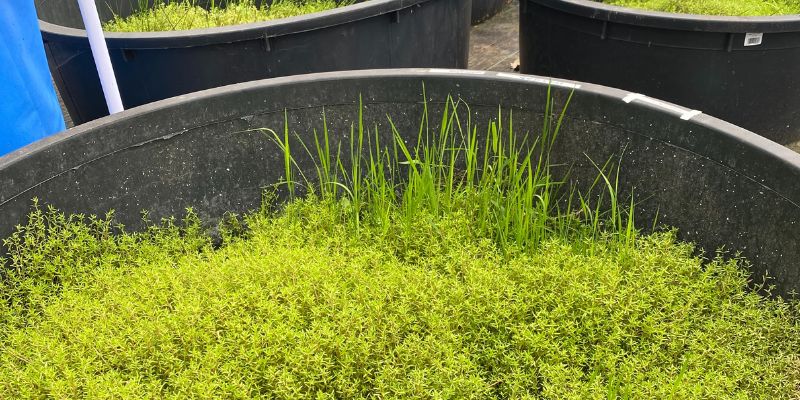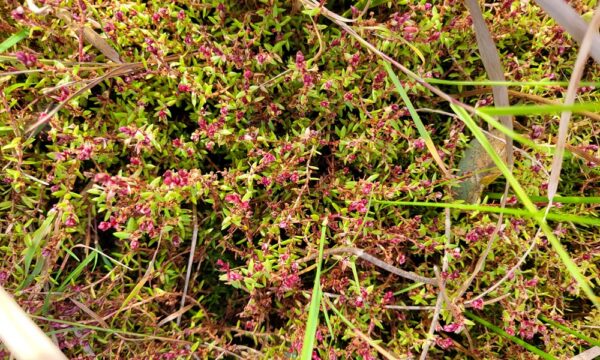Crassula helmsii (also known as Australian swamp stonecrop, New Zealand pygmyweed, or crassula) is an aquatic or semi-terrestrial succulent plant. The species was initially introduced to the UK in the early 1900s as an oxygenating pond plant. It originates in Australia and New Zealand, as its common names suggest.

Capable of growth in semi-terrestrial, emergent, and completely submerged forms, it can carpet vast areas in and around waterways. On top of this, it is tolerant of a wide range of conditions, from flooding to drought and freezing temperatures (down to -7°C). Furthermore, it predominantly reproduces asexually, by vegetative propagation. A plant fragment measuring only half a centimetre containing a single node can produce a new plant.
Crassula – a formidable invasive species

These factors combined make C. helmsii a formidable invasive plant, which can form vast monocultures across and surrounding waterbodies. This, in turn, has many negative environmental and economic impacts. These include displacing native species and reducing biodiversity, decreasing water flow and quality, restricting recreational activities and lowering aesthetic value. Moreover, since minute fragments can rapidly generate whole plants, it is also inevitably spread to new areas on the feet of waterfowl or on the equipment and clothing of humans.
The latter can be prevented by following important biosecurity guidance when around waterbodies. The ‘Check Clean Dry’ campaign provides succinct instructions for any water-faring explorers. In addition, this makes manual control of the plant (by digging or scraping) next to impossible, as any small lost fragments end up rooting and start new patches. What’s more, the use of chemical herbicides is also particularly expensive in economic and environmental terms when surrounding waterbodies.
Potential biocontrols of crassula
On account of these issues, DEFRA commissioned CABI in 2010 to investigate the potential for biological control of Crassula helmsii. The invasive species management team initially surveyed the plant’s native range in Australia, identifying some natural enemies. This included the tiny shoot-galling mite, Aculus crassulae.
The mite’s feeding in new shoots causes abnormal growth and swelling in the plant tissues, developing the tip of the shoot into a gall, which is bright red-pink in colour. The mites live and reproduce inside the galls, only leaving when mature to infect new shoots. To do so, they can move short distances by walking or can go further, ferried on the wind. The damage caused by the mite does not destroy the crassula, but significantly reduces its potency, resulting in stunting and deformed shoots.
Biocontrol testing

Host range testing commenced in 2012, where the mite was meticulously tested in quarantine facilities on 40 species of non-target plants found in the UK, which are related to C. helmsii or are of economic importance. It revealed that the mite is highly host specific, with no significant feeding or reproduction on the non-target plants. Thus, following an extensive review process and Pest Risk Analysis, the A. crassulae mite was approved for release by DEFRA in 2018. This made it Europe’s first approved mite biological control agent!
Since then, crassula from 19 sites across England and Wales has been collected and propagated on-site at CABI Egham, and the mass rearing of the mites commenced to begin the preliminary experimental releases. To begin, the infected galls full of mites are attached with tiny entomology pins to the shoots of C. helmsii plants confined in small boxes. The mite-laden bud then desiccates, causing the mites to migrate over to the healthy plant, thus establishing on the new material. Once repeated, the A. crassulae spread across the small mat of crassula in a given box. The inundated red galls can then be used to infect larger quantities of crassula in ponds.
Crassula mites

Once the plant material from a specific site is sufficiently covered in buds filled with A. crassulae mites, small 20cm squared sections are removed from the ponds or boxes. They are then implanted back to the location where the crassula was originally taken from. Each of these patches is assessed before their release, and always contains upwards of 50 mite-infested galls per patch. Sometimes when the C. helmsii has formed a floating growth form in the field, the infected sections of crassula are made buoyant on a small raft with a mesh base. This allows it to grow into the water, and subsequently infect aquatic growth forms.

With multiple years of experimental releases, the habitat requirements of the mites are increasingly well-understood. A limitation is the mite’s reliance on consistent water levels, so as to not get drowned when levels increase during the winter months. This signifies the importance that an area must be assessed in detail to ensure the appropriate water levels and plant types are available for the A. crassulae mite. Hence, the ability of the mites to establish on the 19 sites has had varied results. Nonetheless, despite these limitations, the mites have overwintered and spread at many of the southerly sites in Great Britain.
Biocontrol symposium
The leading scientist concerning the Aculus crassulae mite biological control, Dr Sonal Varia, is presenting these findings in detail at the 16th International Symposium on Biological Control of Weeds, taking place in Puerto Iguazú, Argentina. The results and following discussions will be exceedingly useful to aid future endeavours in rearing and releasing the first mite biocontrol agent used in Europe.
CABI Biocontrol website
Find out more about CABI’s biocontrol work on five species in the UK, including Australian swamp stonecrop, here.
Project page
Find out more about CABI’s work to find a biocontrol agent for Crassula from the project page.
News story
See also the news story ‘Tiny mite could prove a ‘mighty’ weapon in the fight against one of the UK’s most invasive weeds.’
Related News & Blogs
Biological control in action: Zambia’s field days on fighting fall armyworm
Experts from CABI recently held two field days and an expo in Zambia, showcasing innovative approaches to pest management to 584 farmers, agro-dealers and other stakeholders to help raise awareness of approaches to tackle the invasive fall armyworm (Sp…
11 June 2025




